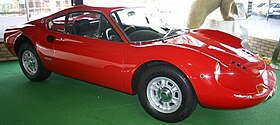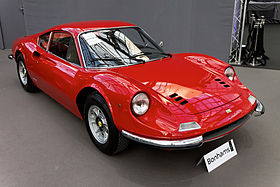Ferrari 246
 |
|
| Owner | Ferrari |
|---|---|
| Country | Italy |
| Introduced | 1968 |
| Discontinued | 1976 |
| Markets | World |
| Dino 206 GT | |
|---|---|
 |
|
| Overview | |
| Production | 1968–1969 |
| Powertrain | |
| Engine | 2.0 L V6 |
| Transmission | 5-speed manual |
| Dino 246 GT and GTS | |
|---|---|
 |
|
| Overview | |
| Production | 1969–1974 |
| Body and chassis | |
| Body style |
Berlinetta Targa top |
| Powertrain | |
| Engine | 2.4 L V6 |
| Transmission | 5-speed manual |
| Dino 308 GT4 2+2 | |
|---|---|
 |
|
| Overview | |
| Manufacturer | Ferrari |
| Production | 1973–1976 (branded as Dino) 1976–1980 (branded as Ferrari) |
| Designer | Marcello Gandini at Bertone |
| Body and chassis | |
| Body style | 2+2 coupé |
| Related | Ferrari 308 GTB |
| Powertrain | |
| Engine | 3.0 L V8 |
| Chronology | |
| Successor | Ferrari Mondial |
Dino [ˈdinɔ] was a marque for mid-engined, rear-drive sports cars produced by Ferrari from 1968 to 1976. Used for models with engines with fewer than 12 cylinders, it was an attempt by the company to offer a relatively low-cost sports car. The Ferrari name remained reserved for its premium V-12 and flat 12 models until 1976, when "Dino" was retired in favour of full Ferrari branding.
Named to honour Ferrari founder Enzo Ferrari's son and heir Dino Ferrari, the Dino models used Ferrari racing naming designation of displacement and cylinder count with two digits for the size of the engine in deciliters and the third digit to represent the number of cylinders, i.e. 246 being a 2.4-litre 6-cylinder and 308 being a 3.0-litre 8-cylinder. Ferrari street models of the time used a three-digit representation of the displacement in cubic centimeters of one of the 12 cylinders, which would have been meaningless in a brand with differing numbers of cylinders.
The "Dino" marque was created to market a lower priced, "affordable" sports car capable of taking on the Porsche 911. Ferrari's expensive V12s well exceeded the 911 in both performance and price. Enzo did not want to diminish his exclusive brand with a cheaper car, so the "Dino" was created.
...
Wikipedia
